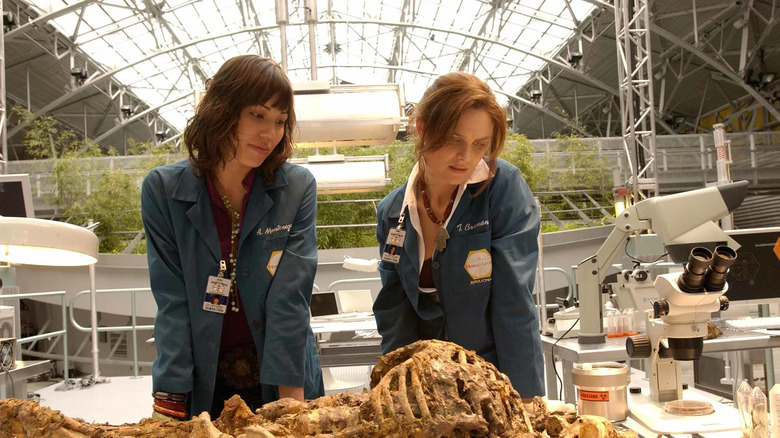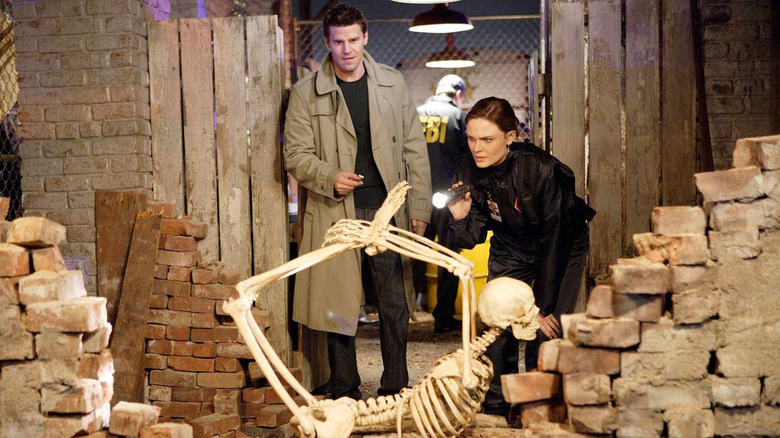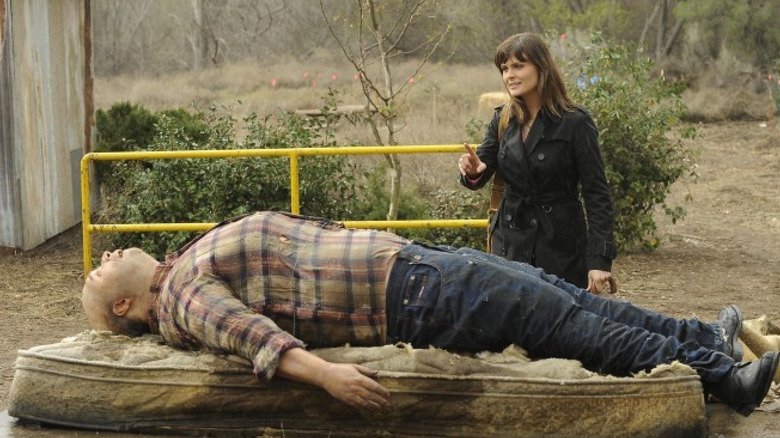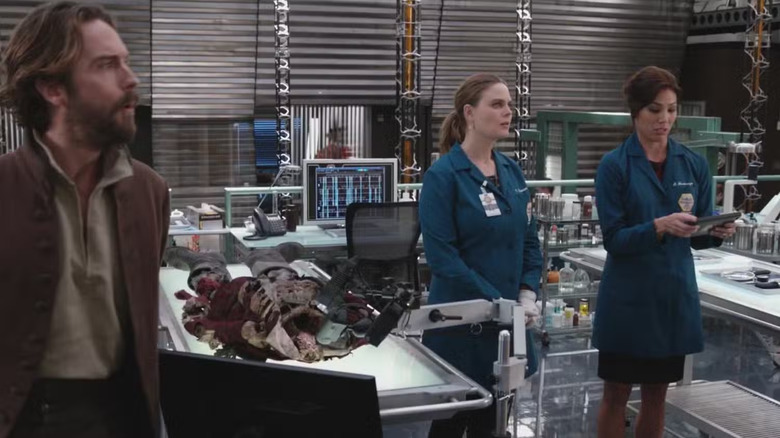Is The Fox TV Series Bones Scientifically Accurate?
No two procedurals are created equal, but the beloved Fox series "Bones" is especially unique, focusing on just one specialty within forensic science. Unlike Dexter Morgan's blood-splatter analysis on "Dexter" or the more traditional forensic pathology of shows like "CSI," Dr. Temperance "Bones" Brennan (Emily Deschanel) and her team deal almost exclusively with, well, bones! Dr. Brennan is a forensic anthropologist at the fictional Jeffersonian Institute, based on the real-life Smithsonian in Washington, D.C., and she uses her skills at identifying information about bodies through their bones to help the FBI solve crimes (particularly agent Seeley Booth, played by David Boreanaz). "Bones" is based on the Temperance Booth books by former real-life forensic pathologist Kathy Reichs, who infused her own personal knowledge into the books and therefore the series — but how accurate is the science, really?
While Reichs is a producer on the series, the writers took some ideas in wildly unrealistic directions and there are a few episodes of "Bones" that are too out-there to ever be considered good science. However, a lot of the concepts in "Bones" are based in real forensic anthropology, and the science is absolutely fascinating.
The real-life science behind forensic anthropology
While Dr. Brennan is loosely based on the experiences of Reichs, there's no real-world equivalent of her character. The FBI does work with other federal agencies to utilize their specialties, but it's usually a big team effort between forensic pathologists, anthropologists, and archaeologists, and one scientist doesn't go around doing all of the work. In an interview with The Huffington Post, expert Dr. Anna Watkins explained that often investigators rely on traditional pathologists because "it sometimes won't occur to anyone in the room that there's a job here for a specific expert, which is a bit like a [general practitioner] not realizing there's a specialist out there to help his patient." She went on to say that while the character wasn't fully accurate to reality, the scientific techniques used generally were.
On "Bones," Dr. Brennan is usually called in when a body has decomposed to the point where only the bones and maybe a tiny bit of tissue are left, with the hopes that she can help identify features of the deceased to help in various murder investigations. (Sometimes she even helps catch serial killers!) Dr. Brennan can sometimes determine the victim's sex and age at time of death, which helps narrow down potential victim identities, though often she is able to do it much more quickly and definitively than her real world counterparts, according to archaeologist Kristina Killgrove. The work that Bones' co-worker Angela (Michaela Conlin) does as a forensic artist is also based in reality, as specialists are able to reconstruct faces based on skeletal remains, which can help investigators identify unknown victims. Both forensic anthropology and forensic artistry are relatively new disciplines, but they are being used more and more as the technology and research behind them grows.
The Body Farm is absolutely a real place
In the season 6 episode "The Feet on the Beach," Dr. Brennan visits a university in New York that has a "body farm," where people who have donated their bodies to science have their remains used for forensic studies. This may seem totally wild, but body farms are real, with the first facility opening in 1981 at the University of Tennessee. There, bodies are placed throughout the forest and left to decompose so that scientists can study just how different elements (like rain or wind) impact decomposition. This kind of thing is used more for the fleshier kinds of forensic science, but Dr. Brennan is still excited to see a body farm up close and personal, and it's understandable because they are so vital in helping learn more about victims and their deaths. Seriously — for those who don't care about what happens to their corpse post-mortem, a body farm is definitely one of the more helpful and interesting places you could choose to end up.
"Bones" has a lot of real science, like body farms, at its foundation because of Reich's involvement, but over the course of 12 seasons and 246 episodes, things occasionally got totally fantastical. This is a series with a "Family Guy" crossover, for Pete's sake, and that kind of thing can mean sacrificing science in the name of entertainment.
Bones often takes serious liberties with its science
While some of the science on "Bones" is totally sound, like using genetic markers shared with a victim to narrow down a list of potential suspects or developing a forensic profile of a victim based on their skeletal remains, some of the show's storylines are pure fantasy. Though the series had a secret weapon in the form of an exec who helped keep the show on the air, sometimes they did crossovers with other Fox shows like "Family Guy" and "Sleepy Hollow." In the "Sleepy Hollow" crossover, Dr. Brennan seems to prove that ghosts exist, and regardless of what psychedelic ghost-hunting queen Kesha says, the existence of ghosts is pseudoscience at best.
For the "Bones" and science-obsessed, Dr. Killgrove has reviewed the series on her website and gone in-depth on the scientific accuracy of each episode from the perspective of a fan who has the knowledge to really dig in. She understands the need for the show to be entertaining and not always totally realistic, and her reviews are a stellar look into the real world of forensic anthropology and archaeology. For everyone else, it's just fun to know that at least some of the fascinating science behind one of television's all-time best forensics experts is accurate, as long as they're not dealing with ghosts or randomly teaming up with the CDC to stop a megavirus. You might say that the show's scientific bones are solid.



